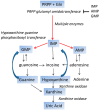Nucleotide salvage deficiencies, DNA damage and neurodegeneration
- PMID: 25923076
- PMCID: PMC4463597
- DOI: 10.3390/ijms16059431
Nucleotide salvage deficiencies, DNA damage and neurodegeneration
Abstract
Nucleotide balance is critically important not only in replicating cells but also in quiescent cells. This is especially true in the nervous system, where there is a high demand for adenosine triphosphate (ATP) produced from mitochondria. Mitochondria are particularly prone to oxidative stress-associated DNA damage because nucleotide imbalance can lead to mitochondrial depletion due to low replication fidelity. Failure to maintain nucleotide balance due to genetic defects can result in infantile death; however there is great variability in clinical presentation for particular diseases. This review compares genetic diseases that result from defects in specific nucleotide salvage enzymes and a signaling kinase that activates nucleotide salvage after DNA damage exposure. These diseases include Lesch-Nyhan syndrome, mitochondrial depletion syndromes, and ataxia telangiectasia. Although treatment options are available to palliate symptoms of these diseases, there is no cure. The conclusions drawn from this review include the critical role of guanine nucleotides in preventing neurodegeneration, the limitations of animals as disease models, and the need to further understand nucleotide imbalances in treatment regimens. Such knowledge will hopefully guide future studies into clinical therapies for genetic diseases.
Figures


References
Publication types
MeSH terms
Substances
Grants and funding
LinkOut - more resources
Full Text Sources
Other Literature Sources
Medical

